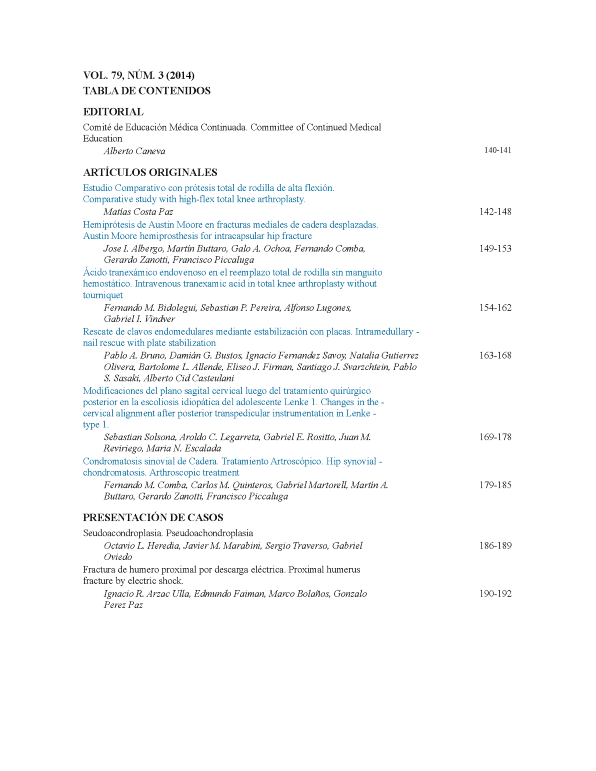Ácido tranexámico endovenoso en el reemplazo total de rodilla sin manguito hemostático. [Intravenous tranexamic acid in total knee arthroplasty without tourniquet.]
Contenido principal del artículo
Resumen
Descargas
Métricas
Detalles del artículo

Esta obra está bajo licencia internacional Creative Commons Reconocimiento-NoComercial-CompartirIgual 4.0.
La aceptación del manuscrito por parte de la revista implica la no presentación simultánea a otras revistas u órganos editoriales. La RAAOT se encuentra bajo la licencia Creative Commons 4.0. Atribución-NoComercial-CompartirIgual (http://creativecommons.org/licenses/by-nc-sa/4.0/deed.es). Se puede compartir, copiar, distribuir, alterar, transformar, generar una obra derivada, ejecutar y comunicar públicamente la obra, siempre que: a) se cite la autoría y la fuente original de su publicación (revista, editorial y URL de la obra); b) no se usen para fines comerciales; c) se mantengan los mismos términos de la licencia.
En caso de que el manuscrito sea aprobado para su próxima publicación, los autores conservan los derechos de autor y cederán a la revista los derechos de la publicación, edición, reproducción, distribución, exhibición y comunicación a nivel nacional e internacional en las diferentes bases de datos, repositorios y portales.
Se deja constancia que el referido artículo es inédito y que no está en espera de impresión en alguna otra publicación nacional o extranjera.
Por la presente, acepta/n las modificaciones que sean necesarias, sugeridas en la revisión por los pares (referato), para adaptar el trabajo al estilo y modalidad de publicación de la Revista.
Citas
2. Goodnough LT, Verbrugge D, Marcus RE. The relationship between hematocrit, blood lost and blood transfused in total knee
replacement. Am J Knee Surg 1995;8:83-7.
3. Mylod AG Jr, France MP, Muser DE, Parsons JR. Perioperative blood loss associated with total knee arthroplasty. A comparison
of procedures performed with and without cementing. J Bone Joint Surg Am 1990;72:1010-2.
4. Burkart BC, Bourne RB, Rorabeck CH, Kirk PG, Nott L. The efficacy of tourniquet release in blood conservation after total
knee arthroplasty. Clin Orthop Relat Res 1994;(299):147-52.
5. Lemaire R. Strategy for blood management in orthopedics and trauma surgery. J Bone Joint Surg Br 2008;90(9):1128-36.
6. Alshryda S, Sarda P, Sukeik M, Nargol A, Blenkinsopp J, Mason JM. Tranexamic acid in total knee replacement: a systematic
review and meta-analysis. J Bone Joint Surg Br 2011;93:1577-85.
7. Benoni G, Bjorkman S, Fredin H. Application of pharmakinetic data from healthy volunteers for the prediction of plasma
concentrations of tranexamic acid in surgical patients. Clin Drug Invest 1995;10(5):280-7.
8. Camarasa MA, Olle G, Serra-Prat M, Martín A, Sánchez M, Ricós P, et al. Efficacy of aminocaproic, tranexamic acids in the
control of bleeding during total knee replacement: a randomized clinical trial. Br J Anaesth 2006;96:576-82.
9. Longstaff C. Studies on the mechanisms of action of aprotinin and tranexamic acid as plasmin inhibitors and antifibrinolytic
agents. Blood Coag Fibrinol 1994;5:537-42.
10. Tanaka N, Sakahashi H, Sato E, Hirose K, Ishima T, Ishii S. Timing of the administration of tranexamic acid for maximum
reduction in blood loss in arthroplasty of the knee. J Bone Joint Surg Br 2001;83:702-5.
11. Benoni G, Fredin H. Fibrinolytic inhibition with tranexamic acid reduces blood loss and blood transfusion after knee arthroplasty:
a prospective, randomised, double-blind study of 86 patients. J Bone Joint Surg Br 1996;78:434-40.
12. Dunn CJ, Goa KL. Tranexamic acid: a review of its use in surgery and other indications. Drugs 1999;57(6):1005-32.
13. Hiippala ST, Strid LJ, Wennerstrand MI, Arvela JV, Niemelä HM, Mäntylä SK, et al. Tranexamic acid radically decreases
blood loss and transfusions associated with total knee arthroplasty. Anesth Analg 1997;84:839-44.
14. Hiippala S, Strid L, Wennerstrand M, Arvela V, Mäntylä S, Ylinen J, et al. Tranexamic acid (Cyklokapron) reduces
perioperative blood loss associated with total knee arthroplasty. Br J Anaesth 1995;74(5):534-7.
15. Ralley FE, Berta D, Binns V, Howard J, Naudie DD. One intraoperative dose of tranexamic acid for patients having primary
hip or knee arthroplasty. Clin Orthop Relat Res 2010;468(7):1905-11. Epub 2010 Jan 9. Erratum in: Clin Orthop Relat Res
2010;468(5):1447.
16. Wong J, Abrishami A, El Beheiry H, Mahomed NN, Roderick Davey J, Gandhi R, et al. Topical application of tranexamic
acid reduces postoperative blood loss in total knee arthroplasty: a randomized, controlled trial. J Bone Joint Surg Am 20103;
92(15):2503-13.
17. Zhi-Gao Y, Wei-Ping C, Li-Dong W. Effectiveness and safety of tranexamic acid in reducing blood loss in total knee arthroplasty:
a meta-analysis. J Bone Joint Surg Am 2012; 94:1153-9.
18. Good L, Peterson E, Lisander B. Tranexamic acid decrease external blood loss but not hidden blood loss in total knee
replacement. Br J Anaesth 2003;90:596-9.
19. Orpen NM, Little C, Walker G, Crawfurd EJ. Tranexamic acid reduces early post-operative blood loss after total knee
arthroplasty: a prospective randomised controlled trial of 29 patients. Knee 2006;13:106-10.
20. Benoni G, Lethagen S, Fredin H. The effect of tranexamic acid on local and plasma fibrinolysis during total knee arthroplasty.
Thromb Res 1997;85(3):195-206.
21. Molloy DO, Archbold HA, Ogonda L, McConway J, Wilson RK, Beverland DE. Comparison of topical fibrin spray and
tranexamic acid on blood loss after total knee replacement: a prospective, randomised controlled trial. J Bone Joint Surg Br
2007;89:306-9.
22. Sano M, Hakusi H, Kojima C, Akimoto T. Absorption and excretion of tranexamic acid following intravenous, intramuscular,
and oral administrations in healthy volunteers. Jpn J Clin Pharmacol Ther 1976;7:375 -82.
23. Ahlberg A, Eriksson O, Kjellman H. Diffusion of tranexamic acid to the joint. Acta Orthop Scand 1976;47:486-8.
24. Cid J, Lozano M. Tranexamic acid reduces allogeneic red cell transfusions in patients undergoing total knee arthroplasty: results
of a meta-analysis of randomized controlled trials. Transfusion 2005; 45(8):1302-7.
25. Hynes M, Calder P, Scott G. The use of tranexamic acid to reduce blood loss during total knee arthroplasty. Knee 2003;10:375-
7.

